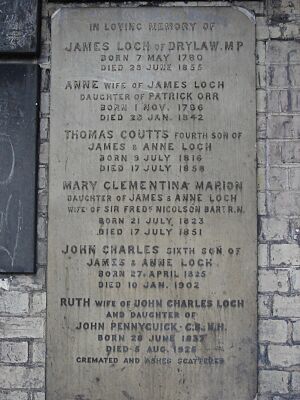James Loch facts for kids
James Loch (born May 7, 1780 – died June 28, 1855) was a Scottish lawyer, called an advocate in Scotland and a barrister in England. He became an expert in managing large land estates and later served as a member of the British Parliament.
Contents
Early Life and Education
James Loch was born near Edinburgh, Scotland, on May 7, 1780. He was the oldest son of George Loch. After his father passed away in 1788, James went to live with his uncle on the Blair Adam estate.
In 1801, James became an advocate in Scotland, which is a type of lawyer who speaks for others in court. Later, in 1806, he was also allowed to practice law in England as a barrister. However, after a few years, he decided to stop working as a lawyer.
Managing Large Estates
James Loch became very interested in how large land estates were managed. He worked as an auditor, which means he checked the financial records and advised on how to run the estates. He worked for several important families, including the Marquis of Stafford (who later became the Duke of Sutherland), Lord Francis Egerton, and the Earl of Carlisle.
In this role, James Loch helped decide how land was used and how farming could be improved across many thousands of acres in both England and Scotland.
The Sutherland Clearances
One of the most significant parts of James Loch's work involved the "Sutherlandshire clearances." Between 1811 and 1820, about 15,000 tenants, or people living on the land, were moved from their homes in the inland areas to the coastal parts of Sutherland. This was done to make way for large-scale sheep farming, which the landowners believed would be more profitable.
James Loch oversaw these changes. He aimed to change the way of life for the people living there. He wrote that the children of those who were moved would "lose all recollection of the habits and customs of their fathers." The moves were often very difficult for the families involved.
Political Career
In June 1827, James Loch became a member of Parliament (MP) for St Germans in Cornwall. He belonged to the Whig political party. He held this seat until 1830.
After that, he was elected to represent the Wick Burghs in Scotland. He was re-elected several times and served as an MP until 1852. In his final election, he was defeated by Samuel Laing.
Writings and Interests
James Loch wrote a pamphlet in 1820 about the improvements made on the Sutherland estates. In 1834, he also privately printed a book about the first Duke of Sutherland.
He was a member of several important groups, including the Geological Society, the Statistical Society, and the Zoological Society. He was also part of the committee for the Useful Knowledge Society, which aimed to spread knowledge to more people.
Later Life and Family
James Loch passed away on June 28, 1855, at his home in London. He was buried in Brompton Cemetery. A monument was built by the Sutherland family near Uppat Farm to mark a spot where he enjoyed looking at the estate he helped manage.
James Loch was married twice. His first marriage was in 1810 to Ann Orr. They had several children, including sons Granville Gower Loch and Henry Brougham Loch. Henry became a well-known figure, serving as governor of the Cape Colony and high commissioner for South Africa.
His second marriage was in 1847 to Elizabeth Mary Pearson, who passed away in 1848.


